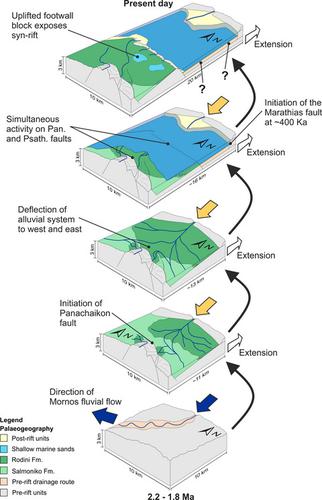当前位置:
X-MOL 学术
›
Basin Res.
›
论文详情
Our official English website, www.x-mol.net, welcomes your feedback! (Note: you will need to create a separate account there.)
Impact of a pre‐existing transverse drainage system on active rift stratigraphy: an example from the Corinth Rift, Greece
Basin Research ( IF 3.2 ) Pub Date : 2019-09-16 , DOI: 10.1111/bre.12396 David J. P. Somerville 1 , Nigel P. Mountney 1 , Luca Colombera 1 , Richard E. Ll. Collier 2
Basin Research ( IF 3.2 ) Pub Date : 2019-09-16 , DOI: 10.1111/bre.12396 David J. P. Somerville 1 , Nigel P. Mountney 1 , Luca Colombera 1 , Richard E. Ll. Collier 2
Affiliation

|
[Abstract Models to explain alluvial system development in rift settings commonly depict fans that are sourced directly from catchments formed in newly uplifted footwalls, which leads to the development of steep‐sided talus‐cone fans in the actively subsiding basin depocentre. The impact of basin evolution on antecedent drainage networks orientated close to perpendicular to a rift axis, and flowing over the developing hangingwall dip slope, remains relatively poorly understood. The aim of this study is to better understand the responses to rift margin uplift and subsequent intrabasinal fault development in determining sedimentation patterns in alluvial deposits of a major antecedent drainage system. Field‐acquired data from a coarse‐grained alluvial syn‐rift succession in the western Gulf of Corinth, Greece (sedimentological logging and mapping) has allowed analysis of the spatial distribution of facies associations, stratigraphic architectural elements and patterns of palaeoflow. During the earliest rifting phase, newly uplifted footwalls redirected a previously established fluvial system with predominantly southward drainage. Footwall uplift on the southern basin margin at an initially relatively slow rate led to the development of an overfilled basin, within which an alluvial fan prograded to the south‐west, south and south‐east over a hangingwall dip slope. Deposition of the alluvial system sourced from the north coincided with the establishment of small‐scale alluvial fans sourced from the newly uplifted footwall in the south. Deposits of non‐cohesive debris flows close to the proposed hangingwall fan apex pass gradationally downstream into predominantly bedload conglomerate deposits indicative of sedimentation via hyperconcentrated flows laden with sand‐ and silt‐grade sediment. Subsequent normal faulting in the hangingwall resulted in the establishment of further barriers to stream drainage, blocking flow routes to the south. This culminated in the termination of sediment supply to the basin depocentre from the north, and the onset of underfilled basin conditions as signified by an associated lacustrine transgression. The evolution of the fluvial system described in this study records transitions between three possible end‐member types of interaction between active rifting and antecedent drainage systems: (a) erosion through an uplifted footwall, (b) drainage diversion away from an uplifted footwall and (c) deposition over the hangingwall dip slope. The orientation of antecedent drainage pathways at a high angle to the trend of a developing rift axis, replete with intrabasinal faulting, exerts a primary control on the timing and location of development of overfilled and underfilled basin states in evolving depocentres., A high‐resolution sedimentological dataset has been analysed from an early syn‐rift section in the Gulf of Corinth, Greece. Interpretation indicates the presence of a dominant transverse alluvial system to the rift axis, deposited over the hangingwall dipslope, resulting in a stacked conglomeratic succession. Results underline the importance of previous drainage catchments and their orientations on early rift stratigraphy. ]
中文翻译:

现有横向排水系统对活动裂谷地层的影响:以希腊科林斯裂谷为例
[解释裂谷环境中冲积系统发展的抽象模型通常描述直接来自新抬升下盘形成的集水区的扇,这导致在主动下沉的盆地沉积中心发展陡峭的距锥扇。盆地演化对接近垂直于裂谷轴并流过发展中的上盘倾角的前驱排水网络的影响,仍然知之甚少。本研究的目的是为了更好地了解对裂谷边缘隆升和随后的盆地内断层发育的响应,以确定主要前驱排水系统冲积沉积物中的沉积模式。来自科林斯湾西部粗粒冲积同裂谷序列的现场采集数据,希腊(沉积学测井和绘图)允许对相关联、地层建筑元素和古流模式的空间分布进行分析。在最早的裂谷阶段,新抬升的下盘改变了以前建立的主要向南排水的河流系统。盆地南部边缘的下盘抬升最初以相对缓慢的速度发展,导致盆地过度充填,其中冲积扇在上盘倾角上向西南、南部和东南推进。源自北部的冲积系统的沉积与源自南部新抬升的下盘的小型冲积扇的建立相吻合。靠近拟建挂壁扇顶点的非粘性碎屑流沉积物逐渐向下游传递到主要是床载砾岩沉积物,表明通过载有沙子和粉砂级沉积物的超浓缩流沉积。随后在上盘发生的正常断层导致了进一步的河流排水障碍,阻塞了向南的流动路线。这最终导致从北部向盆地沉积中心供应沉积物的终止,以及相关的湖侵所表明的盆地条件开始不足。本研究中描述的河流系统的演变记录了活动裂谷和先行排水系统之间三种可能的端元相互作用类型之间的转变:(a)通过抬升的下盘侵蚀,(b) 远离抬升下盘的排水分流和 (c) 上盘倾角上的沉积。前驱排水通道的方向与发育中的裂谷轴的趋势呈大角度,充满盆地内断层,对演化沉积中心中过充填和欠充填盆地状态的发展时间和位置起到主要控制作用。已经从希腊科林斯湾的早期同裂谷剖面分析了沉积学数据集。解释表明,在裂谷轴上存在一个占主导地位的横向冲积系统,沉积在上盘倾角上,导致堆积的砾岩序列。结果强调了以前的排水集水区及其在早期裂谷地层学中的方向的重要性。] 前驱排水通道的方向与发育中的裂谷轴的趋势呈大角度,充满盆地内断层,对演化沉积中心中过充填和欠充填盆地状态的发展时间和位置起到主要控制作用。已经从希腊科林斯湾的早期同裂谷剖面分析了沉积学数据集。解释表明,在裂谷轴上存在一个占主导地位的横向冲积系统,沉积在上盘倾角上,导致堆积的砾岩序列。结果强调了以前的排水集水区及其在早期裂谷地层学中的方向的重要性。] 前驱排水通道的方向与发育中的裂谷轴的趋势呈大角度,充满盆地内断层,对演化沉积中心中过充填和欠充填盆地状态的发展时间和位置起到主要控制作用。已经从希腊科林斯湾的早期同裂谷剖面分析了沉积学数据集。解释表明,在裂谷轴上存在一个占主导地位的横向冲积系统,沉积在上盘倾角上,导致堆积的砾岩序列。结果强调了以前的排水集水区及其在早期裂谷地层学中的方向的重要性。] 对演化中的沉积中心中过度充填和欠充填盆地状态的发展时间和位置施加主要控制。已经分析了来自希腊科林斯湾的早期同裂谷剖面的高分辨率沉积学数据集。解释表明,在裂谷轴上存在一个占主导地位的横向冲积系统,沉积在上盘倾角上,导致堆积的砾岩序列。结果强调了以前的排水集水区及其在早期裂谷地层学中的方向的重要性。] 对演化中的沉积中心中过度充填和欠充填盆地状态的发展时间和位置施加主要控制。已经分析了来自希腊科林斯湾的早期同裂谷剖面的高分辨率沉积学数据集。解释表明,在裂谷轴上存在一个占主导地位的横向冲积系统,沉积在上盘倾角上,导致堆积的砾岩序列。结果强调了以前的排水集水区及其在早期裂谷地层学中的方向的重要性。] 解释表明,在裂谷轴上存在一个占主导地位的横向冲积系统,沉积在上盘倾角上,导致堆积的砾岩序列。结果强调了以前的排水集水区及其在早期裂谷地层学中的方向的重要性。] 解释表明,在裂谷轴上存在一个占主导地位的横向冲积系统,沉积在上盘倾角上,导致堆积的砾岩序列。结果强调了以前的排水集水区及其在早期裂谷地层学中的方向的重要性。]
更新日期:2019-09-16
中文翻译:

现有横向排水系统对活动裂谷地层的影响:以希腊科林斯裂谷为例
[解释裂谷环境中冲积系统发展的抽象模型通常描述直接来自新抬升下盘形成的集水区的扇,这导致在主动下沉的盆地沉积中心发展陡峭的距锥扇。盆地演化对接近垂直于裂谷轴并流过发展中的上盘倾角的前驱排水网络的影响,仍然知之甚少。本研究的目的是为了更好地了解对裂谷边缘隆升和随后的盆地内断层发育的响应,以确定主要前驱排水系统冲积沉积物中的沉积模式。来自科林斯湾西部粗粒冲积同裂谷序列的现场采集数据,希腊(沉积学测井和绘图)允许对相关联、地层建筑元素和古流模式的空间分布进行分析。在最早的裂谷阶段,新抬升的下盘改变了以前建立的主要向南排水的河流系统。盆地南部边缘的下盘抬升最初以相对缓慢的速度发展,导致盆地过度充填,其中冲积扇在上盘倾角上向西南、南部和东南推进。源自北部的冲积系统的沉积与源自南部新抬升的下盘的小型冲积扇的建立相吻合。靠近拟建挂壁扇顶点的非粘性碎屑流沉积物逐渐向下游传递到主要是床载砾岩沉积物,表明通过载有沙子和粉砂级沉积物的超浓缩流沉积。随后在上盘发生的正常断层导致了进一步的河流排水障碍,阻塞了向南的流动路线。这最终导致从北部向盆地沉积中心供应沉积物的终止,以及相关的湖侵所表明的盆地条件开始不足。本研究中描述的河流系统的演变记录了活动裂谷和先行排水系统之间三种可能的端元相互作用类型之间的转变:(a)通过抬升的下盘侵蚀,(b) 远离抬升下盘的排水分流和 (c) 上盘倾角上的沉积。前驱排水通道的方向与发育中的裂谷轴的趋势呈大角度,充满盆地内断层,对演化沉积中心中过充填和欠充填盆地状态的发展时间和位置起到主要控制作用。已经从希腊科林斯湾的早期同裂谷剖面分析了沉积学数据集。解释表明,在裂谷轴上存在一个占主导地位的横向冲积系统,沉积在上盘倾角上,导致堆积的砾岩序列。结果强调了以前的排水集水区及其在早期裂谷地层学中的方向的重要性。] 前驱排水通道的方向与发育中的裂谷轴的趋势呈大角度,充满盆地内断层,对演化沉积中心中过充填和欠充填盆地状态的发展时间和位置起到主要控制作用。已经从希腊科林斯湾的早期同裂谷剖面分析了沉积学数据集。解释表明,在裂谷轴上存在一个占主导地位的横向冲积系统,沉积在上盘倾角上,导致堆积的砾岩序列。结果强调了以前的排水集水区及其在早期裂谷地层学中的方向的重要性。] 前驱排水通道的方向与发育中的裂谷轴的趋势呈大角度,充满盆地内断层,对演化沉积中心中过充填和欠充填盆地状态的发展时间和位置起到主要控制作用。已经从希腊科林斯湾的早期同裂谷剖面分析了沉积学数据集。解释表明,在裂谷轴上存在一个占主导地位的横向冲积系统,沉积在上盘倾角上,导致堆积的砾岩序列。结果强调了以前的排水集水区及其在早期裂谷地层学中的方向的重要性。] 对演化中的沉积中心中过度充填和欠充填盆地状态的发展时间和位置施加主要控制。已经分析了来自希腊科林斯湾的早期同裂谷剖面的高分辨率沉积学数据集。解释表明,在裂谷轴上存在一个占主导地位的横向冲积系统,沉积在上盘倾角上,导致堆积的砾岩序列。结果强调了以前的排水集水区及其在早期裂谷地层学中的方向的重要性。] 对演化中的沉积中心中过度充填和欠充填盆地状态的发展时间和位置施加主要控制。已经分析了来自希腊科林斯湾的早期同裂谷剖面的高分辨率沉积学数据集。解释表明,在裂谷轴上存在一个占主导地位的横向冲积系统,沉积在上盘倾角上,导致堆积的砾岩序列。结果强调了以前的排水集水区及其在早期裂谷地层学中的方向的重要性。] 解释表明,在裂谷轴上存在一个占主导地位的横向冲积系统,沉积在上盘倾角上,导致堆积的砾岩序列。结果强调了以前的排水集水区及其在早期裂谷地层学中的方向的重要性。] 解释表明,在裂谷轴上存在一个占主导地位的横向冲积系统,沉积在上盘倾角上,导致堆积的砾岩序列。结果强调了以前的排水集水区及其在早期裂谷地层学中的方向的重要性。]



























 京公网安备 11010802027423号
京公网安备 11010802027423号